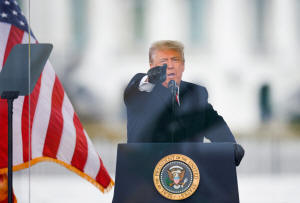Trump ends his term like a growing number of Americans: out of a job
 Send a link to a friend
Send a link to a friend
 [January 09, 2021] By
Dan Burns [January 09, 2021] By
Dan Burns
(Reuters) - The final employment scorecard
delivered during President Donald Trump's administration on Friday
handed the Republican a mantle no politician would envy: He will be the
only modern president to leave office with fewer U.S. jobs than when his
term began.
A global pandemic that Trump - who lost his bid for re-election to
Democrat Joe Biden in November - was late to recognize and prone to
downplay or outright deny through much of its course laid waste to the
U.S. economy in the final year of his term. It erased all semblance of
the booming job market that he had hoped would vault him to a second
term.
Instead, as the Labor Department reported on Friday, total U.S.
employment fell in December by 140,000 to 142.6 million, roughly 10
million fewer jobs than before the coronavirus pandemic struck.
The economic record books will count January's employment figures in
Trump's column since he leaves office near the end of the month on Jan.
20. This month's data will be reported in early February.

But there is no realistic expectation that payrolls will rebound enough
to close the gap of roughly 3 million jobs between December's level and
that of January 2017, when Trump took office.
Trump's final year in office was punctuated with economic superlatives,
effectively all of them brought on by COVID-19 and the wave of
restrictions on business and activity imposed to try to contain its
rapid and deadly spread.
The outbreak - which has now infected nearly 21.5 million U.S. residents
and killed more than 365,000 - triggered the swiftest and deepest
recession of the post-World War Two era.
The unemployment rate rocketed from a half-century low of 3.5% in
February 2020 to 14.8% in just two months as more than 22 million people
were thrown out of work. While it has come down since to 6.7%, it is 2
percentage points higher than it was when he was sworn into office.
On that front, at least, Trump has company: He is the third Republican
president in a row to leave office with a higher jobless rate than on
his inauguration. Both President George W. Bush and President George H.
W. Bush oversaw rising unemployment rates during their terms.
Through his first three years in office, Trump often pointed to the
improving job market for Blacks in stump speeches, claiming no other
American president had done as much to improve the lot of African
Americans.
[to top of second column] |

President Donald Trump gestures as he speaks during a rally to
contest the certification of the 2020 U.S. presidential election
results by the U.S. Congress, in Washington, U.S, January 6, 2021.
REUTERS/Jim Bourg

Some data bears that out. The Black jobless rate in late 2019 did fall to 5.2% -
the lowest since the Labor Department began tracking it. That was still nearly 2
points higher than the rate for whites.
By December 2019, Black employment levels across the country had risen by 8.1%
from where they were when Democrat Barack Obama - the first Black president and
Trump's predecessor - left office. By contrast job growth over that span for
whites was 3.3% - albeit from a much larger base.
But COVID-19 wiped out all of those gains, and while Black employment levels
have come closer to where they were at the start of Trump's term, levels for
both Blacks and whites remain below that.
Trump came to office promising a manufacturing renaissance as part of his
America-first agenda under which he railed against imported goods and companies
that had sent factories overseas.
There was some modest improvement in his first three years, with total
manufacturing employment rising by 3.8%. But other sectors - especially in
services - accounted for most of the job gains to then.
And it was to the services sector that COVID-19 dealt its harshest blow.
Jobs in the leisure and hospitality industries in particular suffered from
measures to prevent the spread of the disease, and the newest surge in
infections has revisited pain on the sector. While 140,000 jobs were lost
overall last month, nearly 500,000 were shed in leisure in leisure and
hospitality, and total employment in the sector is 18.5% lower than when Trump
took the oath of office.

And what about manufacturing? There are 60,000 fewer factory jobs today than in
January 2017.
(Reporting By Dan Burns; Editing by Cynthia Osterman)
[© 2021 Thomson Reuters. All rights
reserved.] Copyright 2021 Reuters. All rights reserved. This material may not be published,
broadcast, rewritten or redistributed.
Thompson Reuters is solely responsible for this content. |